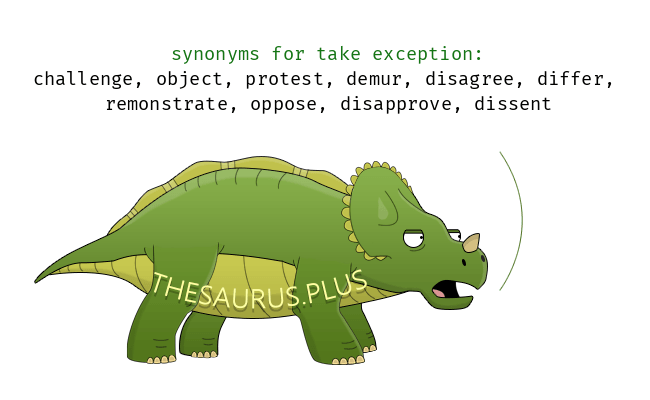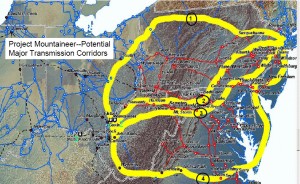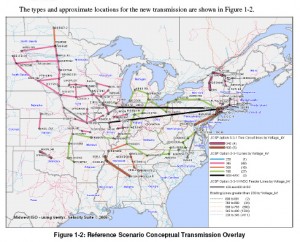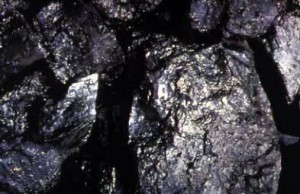Exceptions to ALJ’s Freeborn Recommendation
June 9th, 2018

Here’s the Recommendation of the Administrative Law Judge.
In short:

Exceptions of parties to the Freeborn Wind siting permit proceeding:
Freeborn_Exceptions_20186-143678-02
Exceptions of “affected parties”
Cookie cutter cut and paste form letters with minor modifications:
Here’s a late filed one, another form letter:
JCSP Big Picture – who pays? WE DO!
July 2nd, 2013
Transmission — it’s all connected. In looking at the Minnesota rulemaking, and the existing and proposed rules that utilize the word “regional,” I’m thinking about big picture stuff, the big proposals in the wings, and that Joint Coordinated System Plan (JCSP) map sure presents a big picture. For some reason, I’ve not been able to find the full JCSP report until recently:
Who cares about JCSP? Well, WE’D better care, because look who’s paying for the transmission build-out (p. 68 of Vol. 1):
Look at the numbers for Midwest ISO, a $-10,293, or for MAPP, a $12,292, that’s a COST, not a savings. MISO and MAPP get nominal production cost savings and massive load COSTS. This is not news, but is worth repeating as we discuss “regional.” And another take with the same take-away of big costs for MISO and MAPP customers, used by our good friends at AWEA to promote this transmission buildout in their flyer called “Green Power Transmission and Consumer Savings” (flyer below):
Read the whole thing:
What a deal, eh?
Look what AWEA has been advocating to make this happen:
FERC cost-apportionment docket heats up
February 24th, 2010
The cost apportionment remand at FERC is heating up. It’s that case where the 7th Circuit threw out the PJM cost apportionment scheme:
It went back to FERC and so FERC issued an Order requiring PJM to produce things that… well… things that will demonstrate that there’s no need for this project, things that will demonstrate the benefactor of these transmission lines, things that PJM doesn’t really want the world to know, like how they’ve incorporated O-P-T-I-M-I-Z-A-T-I-O-N, things going directly to N-E-E-D!
Seeing that, well, Stop the Lines had to join in, as did the Municipal Intervenors:
PJM begged for more time, an extension of 45 days!
And for some bizarre reason, FERC gave it to them:
Meanwhile, Exelon wants to bring in the kitchen sink, including 345kV transmission:
And parties they are a freakin’ and filing:
And then the weirdest of all – the American Wind Energy Ass (AWEA) wants to intervene, citing “the current significance of this issue in the context of efforts to build transmission to bring location-constrained, renewable resources to load…” Ummmm… SAY WHAT??
OK, I give up… in what parallel or alternate universe is the PATH or Susquehanna-Roseland line for wind? WHERE DO THEY GET THESE IDEAS? I want to see the basis for that statement. PRODUCE!
Earth to AWEA — can you spell P-R-O-J-E-C-T M-O-U-N-T-A-I-N-E-E-R?
If you need a hint, go to FERC eLibrary and search for A05-03. Happy reading!
Offshore transmission, NOT transmission from Midwest
December 6th, 2009
By standing up for offshore transmission for wind, Delaware’s Gov. Jack Markell stands up to Midwest coal!
The Mid-Atlantic states have been standing up and opposing transmission from the Midwest. They’ve gone on record in a number of venues, and in their opposition are citing Midwest transmission promoters’ disregard for eastern renewable efforts, that xmsn may well not be an economical way to get power to the east, and that THEY KNOW THAT MIDWEST TRANSMISSION PLANS INHERENTLY ARE ABOUT COAL. The plan they’re referring to is a massive transmission buildout known as JCSP, and it also applies to the big PJM buildout that includes the PA-NJ Susquehanna-Roseland transmission line that was the subject of a hearing last month.
Here’s JCSP (Joint Coordinated System Plan) note their site now talks about wind — but look where the transmission starts, DUH! The coal fields of the Dakotas:
Gotta give them, Delaware, Maryland and Virginia, a lot of credit for recognizing and stating what Midwest states have been unwilling to admit.
That said, here’s what Mid-Atlantic states are doing — they’re banding together to propose offshore transmission. If it’s underwater offshore transmission, that’s an idea that’s hard not to like. But I’ll bet it throws PJM for a loop, what with all their “backbone” transmission schemes, a la Project Mountaineer, that are in the works:
The FERC birth of Project Mountaineer:
And you can see that those lines in play now, PJM’s “backbone” transmission projects like Susquehanna-Roseland (NE part of Project Mountaineer Line 1) and MAPP (NE part of Project Mountaineer Line 4) are part of the plan… the big transmission plan that does not work for the east coast.
Here’s the Memorandum of Understanding between Delaware, Maryland and Virginia:
And recently, Gov. Jack Markell addressed these issues before American Wind Energy Association’s offshore windfest — but given the PJM big-transmission-projects-from-hell are referred to as “backbone” projects, I wish they’d find another term:
Delaware energy: ‘Backbone’ power line pushed for wind farms
By AARON NATHANS
The News JournalGov. Jack Markell broached the subject this week in his address to the American Wind Energy Association’s offshore wind workshop, the industry event of the year on this side of the Atlantic. Markell signed onto letters the governors sent to members of Congress this summer, and the Federal Energy Regulatory Commission last month.
“Let’s have the conversation,” O’Mara said. “It’s extremely worthy of further study.”
“It obviously won’t happen in the absence of federal leadership,” he said.
Fishermen’s Energy President Daniel Cohen said it’s a good idea, but “it’s another moving part.”
The benefits of building lines transmitting wind power from the Midwest are less certain, he said.
“It will be difficult to get progress in this area until there are clear national goals,” he said.
Note that “cost allocation” is raised. Since the 7th Circuit decision tossing out FERC approval of PJM’s transmission cost allocation dream/nightmare, all transmission projects 500kV and over based on that cost allocation scheme are in limbo.
So as noted, who pays, and submarine transmission is EXPENSIVE, is THE big issue now. It’s the big issue for land transmission, it’s the big issue for offshore transmission, and, given the uncertainty since the 7th Circuit decision, maybe some of the sturm and drang could be circumvented if it’s designed at 345kV or below, and uses the “benefactor pays” theory. We shall see…




